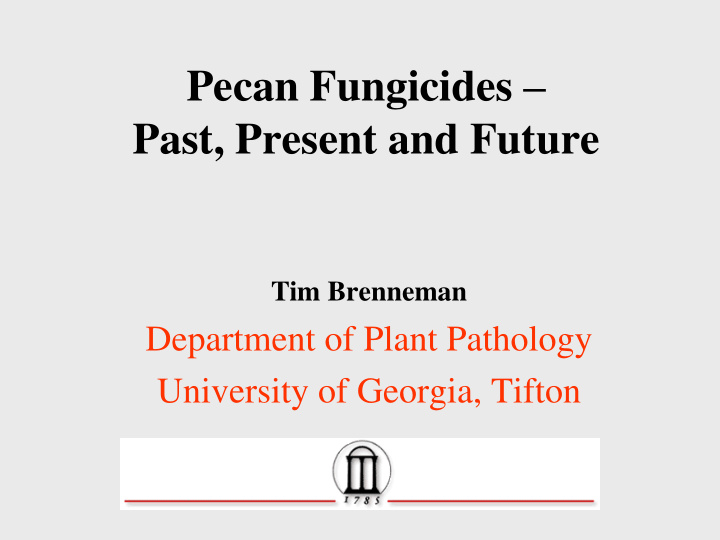



Pecan Fungicides – Past, Present and Future Tim Brenneman Department of Plant Pathology University of Georgia, Tifton
We’re getting better equipment, but what do we have in the tank? (Recent budgets list $150-250/A for fungicides)
Fungicide Classes (Welcome to Intro Plant Pathology!) 1. Inorganics 2. Organometallics 3. Organic Protectants 4. Organic Systemics
I. Inorganics – ex. Sulfur Known by Greeks, rediscovered by French in 1850 for vineyards w/ powdery mildew Common even today, usually low cost, but often not real effective (dusting peanuts) Phytotoxocity an issue, especially at high temperatures and/or with oils
Sulfur on Pecans • Primary use has been for powdery mildew • DMI’s and QoI’s are much better (Absolute, Quilt, etc. superb) • Recent work showing S + DMI better results than DMI alone on peanut leaf spot
Sulfur enhances pecan nut weight (HortScience - Wells, Brock and Brenneman, 2014) • Foliar S had no effect on scab and no effect on the percent kernel • S increased both leaf chlorophyll and nut size 2/3 years (size matters!)
I. Inorganics – ex. Copper Strict protectant, effective on some fungi and bacteria, must be reapplied 5-10 days Bordeaux Mixture; 1 st effective foliar fungicide (copper sulfate + lime) found by accident to control downy mildew of grapes ( Alexis Millardet in 1885), and still used today (reduced phytotoxicity) Various coppers labeled on pecans, but to date they have provided only modest scab control
II. Organic Protectants Dithiocarbamates found in 1930’s Easier to use, more effective, and less phytotoxic than Bordeaux. Ziram is still used today as a multi-site TPTH replacement when dealing with tin- resistant populations (6 lb/A was better than tin last year in “problem” orchards, but cost is an issue).
II. Organic Protectants Dodine (Elast) developed in the 1950’s It’s a cationic surfactant toxic to fungi and bacteria. Adsorbs strongly to cuticle so it resists washoff, and can be an antisporulant. Can be phytotoxic to some older cultivars, and can have resistance issues (more so in other crops). Not good on several minor diseases, but vital to our nut scab programs.
III. Organometallics Organotins (1960’s) Triphenyl tin hydroxide (TPTH) used on sugar beets and pecans (at times exclusively). Worker exposure and environmental issues, phytotoxic on some crops such as peanuts, and has antifeeding traits for insects. RESISTANCE????? Tin and Elast have been the “Twin Towers” of our pecan spray programs, especially for nut scab.
2014 fungicide sensitivity survey of orchards in Georgia
“Fitness Cost” of tin resistance with 10 sprays of TPTH per year (Standish, Stevenson and Brenneman, 2017) 75 % Resistant 50 25 0 6/1/16 9/1/16 6/1/17 9/1/17
2017 On Farm Trials (Kory Herrington, UGA MS student) • 9 “high risk” commercial orchards in South Georgia • Treated Individual Terminals on non-sprayed trees • Hand sprayed each terminal • Fungicide @ full rate diluted to 100 GPA • 10 applications @ 2 week intervals
“On Farm” Scab Trials, 2017 (Super Tin, 12 oz/A, 10 sprays)
“The rumors of my demise have been greatly exaggerated!” Mark Twain The same appears to be true of TPTH on pecans (thankfully!)
IV. Organic Systemics First found in 1966 and revolutionized disease control with reduced wash-off, post-infection activity, lower rates, etc. benzimidazoles; highly effective, but “poster 1. child” for fungicide resistance, which occurred in as little as 2 years due to a single gene mutation (ex. Benlate or Topsin) Use only 1- 2 app’s per year in a tank mix
IV. Organic Systemics Sterol Demethylation Inhibitors (DMI’s) 2. - prevent ergosterol formation which fungi need for membrane integrity – widely used (and abused), especially since Folicur (tebuconazole) went generic - Better on leaf scab (Enable good on nuts), but both are compromised by resistance - Difenconazole (Quadris Top) w/ excellent activity, even on DMI-resistant isolates
Nut Scab Control w/ DMI’s + Organotins
Nut Scab Control w/ Quadris Top (QoI + DMI)
IV. Organic Systemics Strobilurins were discovered from metabolites 3. produced in nature by wood-rotting fungi ( Strobilurus tenacellus ). - widely used on may diseases since 1990’s (ex. Sovran, Headline, Abound, etc.) - some resistance issues, but not as severe in pecans as in many other crops (need to know more, but must look at genes for resistance!)
QoI/Strobiluruns
IV. Organic Systemics 4. Carboximides/SDHI (Group 7)- disrupts fungal respiration (succinate dehydrogenase inhibitors) - older chemistry, early ones were very effective but narrow spectrum (ex. Vitavax & Convoy) or not good on scab (ex. Fontellis) - latest ones are more broadly active and NOT cross-resistant to triazoles or strobilurins, and some are very active on scab - the new, “gee whiz” products are SDHI’s showing outstanding disease control on a variety of crops, and some are even nematicides (fluopyram)
What about the “Phites”? (Phosphorous acid) • Different mode of action, highly systemmic, relatively cheap, mixes with other chemistry, and active on a multiple pecan diseases, including scab (on leaves) • Issue has been residues on exports to EU • GREAT NEWS – The European Food Safety Authority is expected to approve an MRL of 500 ppm (vs 2) in near future!!!!!
We have a great arsenal of fungicides – lets use them wisely! April 20
Acknowledgements • Dr. Katy Stevenson • Kory Herrington • Jeff Standish Cooperators • Brent Biles The Georgia Agricultural • Nilo Plantation Commodity Commission for Pecans • Mitch Bulger • Buck Paulk • Sonny Able • Clint Ray
Recommend
More recommend